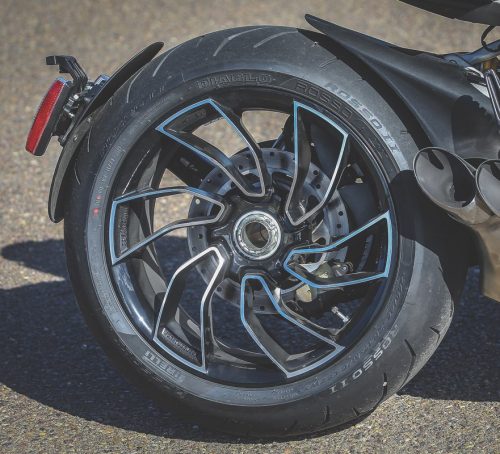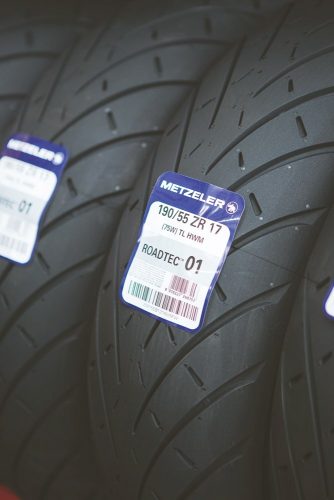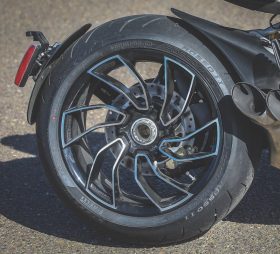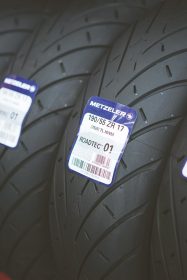A friend recently asked about tires for his vintage Japanese bike, since the original-size rear was no longer available. Having knowledge of tire markings, I suggested a suitable alternative.
 Most tire makers these days use the metric sizing system, which looks like this: 100/90-19, representing, in order, the width of the tire in millimetres, the aspect ratio, and the rim diameter in inches. In this example, the tire is 100 mm wide, though the actual measurement may vary by as much as 10 mm. The aspect ratio is a percentage that represents the height of the tire from the bead (the inside edge of the tire) to the top of the tread, at the centre. Here, the tire is 90 per cent as tall as it is wide, or about 90 mm. Lastly, the tire diameter in this example means it mounts on a 19-inch wheel. If the original tire size is not available, you can calculate the width versus height of alternative sizes to find something very close. For my friend’s Honda NS400, I recommended a 120/80-17 rear to replace the unavailable 110/90-17.
Most tire makers these days use the metric sizing system, which looks like this: 100/90-19, representing, in order, the width of the tire in millimetres, the aspect ratio, and the rim diameter in inches. In this example, the tire is 100 mm wide, though the actual measurement may vary by as much as 10 mm. The aspect ratio is a percentage that represents the height of the tire from the bead (the inside edge of the tire) to the top of the tread, at the centre. Here, the tire is 90 per cent as tall as it is wide, or about 90 mm. Lastly, the tire diameter in this example means it mounts on a 19-inch wheel. If the original tire size is not available, you can calculate the width versus height of alternative sizes to find something very close. For my friend’s Honda NS400, I recommended a 120/80-17 rear to replace the unavailable 110/90-17.
The older standard inch system is rarely used, but it looks like this:
3.50-19. This size only provides the width of the tire and the rim diameter, which in this case would be about 3.5 inches and 19 inches, respectively. The aspect ratio of these tires is usually about 100 per cent. The closest metric equivalent for this size would be 90/90-19.
The low-profile inch system looks very similar to the standard inch system, except that the aspect ratio is either 82 (default) or 85 per cent. A tire size of 4.25-18 measures 4.25 inches wide and would have an aspect ratio of 82 per cent (unspecified default), or about 3.5 inches tall. If the tire were marked 4.25/85-18, it would have an aspect ratio of 85 per cent, or a cross section 3.6 inches tall. You can still find tires in either inch sizing systems, though they are usually vintage reproduction tires or odd off-road tires.
 Finally, there’s the alphanumeric system, which looks like this: MT90-16. In this system, the first letter, always an M, indicates the tire is manufactured for motorcycle use. The second letter is the tire width. The most common alphanumeric widths are MH, MJ, ML, MT and MU, which translate into 3, 3.25, 3.5, 5 and 5.5 inches wide, respectively. The first number in this system is the aspect ratio, and the last is the rim diameter.
Finally, there’s the alphanumeric system, which looks like this: MT90-16. In this system, the first letter, always an M, indicates the tire is manufactured for motorcycle use. The second letter is the tire width. The most common alphanumeric widths are MH, MJ, ML, MT and MU, which translate into 3, 3.25, 3.5, 5 and 5.5 inches wide, respectively. The first number in this system is the aspect ratio, and the last is the rim diameter.
Other important tire identifiers are the speed index, which usually appears just before the rim size (100/90H19), and the tire construction: B for belted tires and R for radials (120/70R17). The speed index is the maximum speed that the tire can be used at while carrying the maximum load according to its load rating. The most commonly used speed ratings are S (180 km/h), H (210 km/h), V (240 km/h) and Z (more than 240 km/h). The speed index is often combined with the load index, usually located after the tire size, and appears like this: 62H. In this example, the tire can withstand a load of 265 kg (584 lb.) and has an H speed index. The motorcycle tire load index ranges from 51 (195 kg) to 68 (315 kg).
Less conspicuous are the tread wear indicators, located in several spots on the sidewall, right at the edge of the tread. These are identified by the letters TWI and usually have a small arrow pointing toward the tread. The TWI is a raised band of rubber running radially across the tread, usually measuring about 2/32 inch, and which becomes visible when the tire tread has worn down to its minimum height. When the TWI is exposed at the centre of the tread, it means it’s time to replace the tire.
Another important marking to look for, especially when buying off-road tires for an adventure-touring bike, is the one identifying if it is a tube-type or tubeless tire. You’ll see either “TT” or “Tube Type” for a tire requiring an inner tube, or “TL” or “Tubeless” on a tubeless tire. This is very important, because even though you can install an inner tube in a tubeless tire, you cannot run a tube-type tire on a tubeless rim. You can mount a tube-type tire on a tubeless rim, but the bead won’t mate properly with the rim and it will leak without a tube.
All street-legal motorcycle tires have a DOT serial number, beginning with the letters DOT and ending with a four-digit date code; the first two digits of the date code indicate the week of manufacture, with the last two indicating the year. A 2417 code indicates the tire was manufactured in the 24th week of 2017. Look for this when buying a used bike. Generally, five years is the accepted life span of a tire, however, this varies on how it’s been stored. For instance, its lifespan would be less if it were left outdoors in the elements and in the sun.
Technical articles are written purely as reference only and your motorcycle may require different procedures. You should be mechanically inclined to carry out your own maintenance and we recommend you contact your mechanic prior to performing any type of work on your bike.












